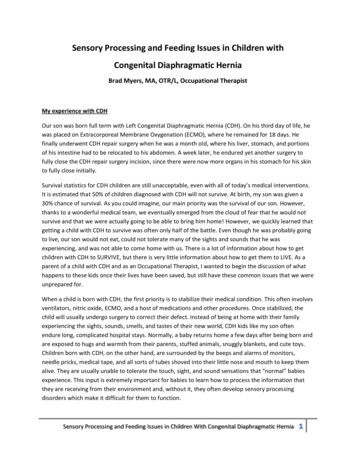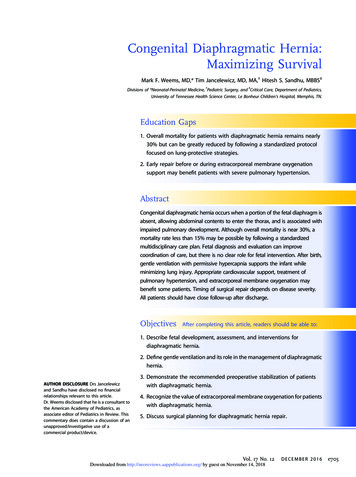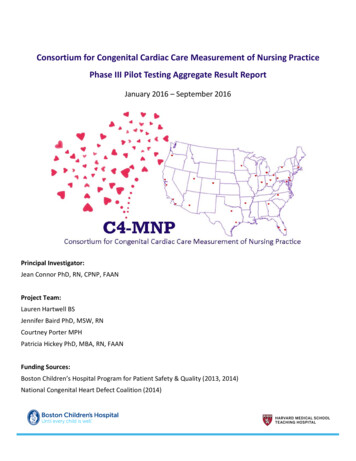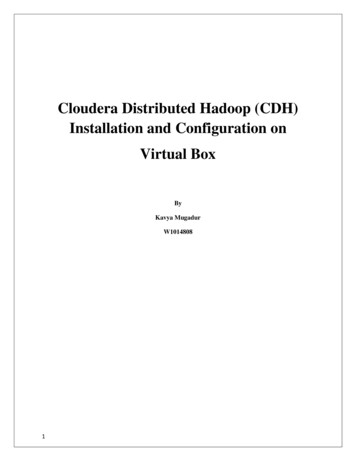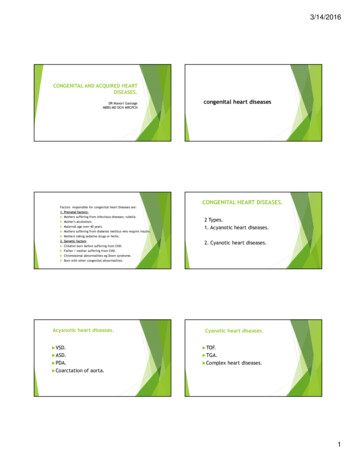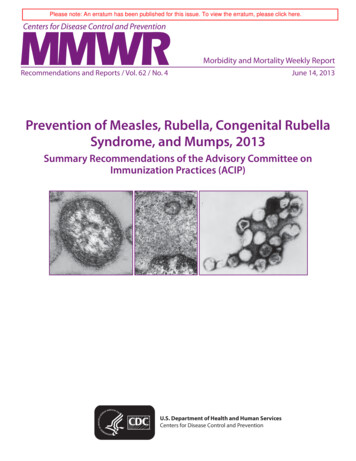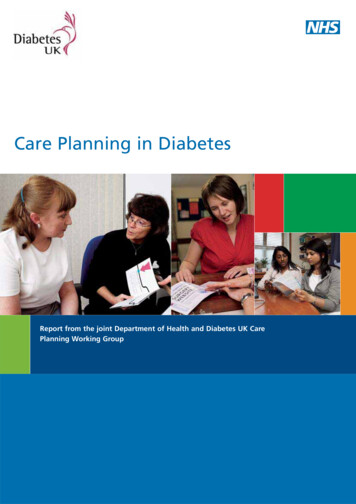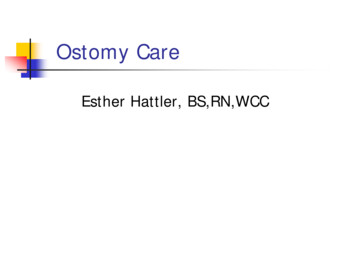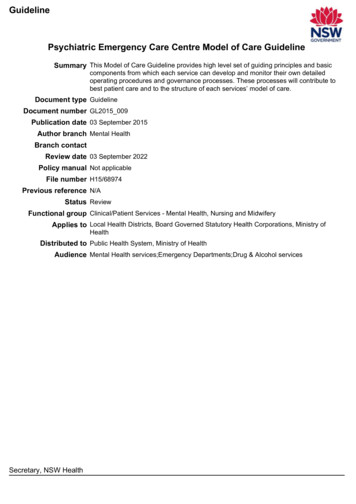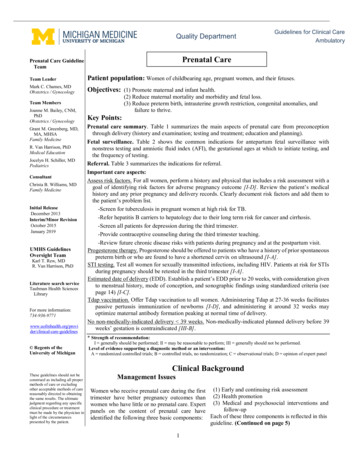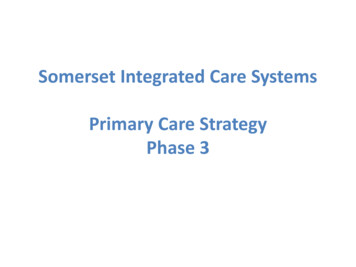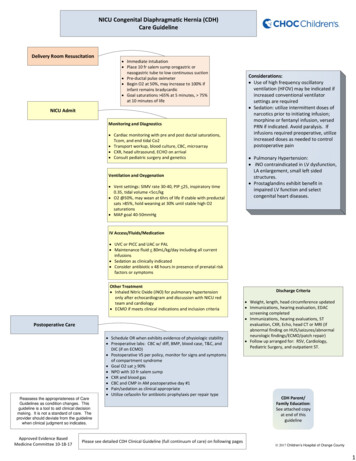
Transcription
NICU Congenital Diaphragmatic Hernia (CDH)Care GuidelineDelivery Room Resuscitation Immediate intubation Place 10 fr salem sump orogastric ornasogastric tube to low continuous suction Pre‐ductal pulse oximeter Begin O2 at 50%, may increase to 100% ifinfant remains bradycardic Goal saturations 65% at 5 minutes, 75%at 10 minutes of lifeNICU AdmitMonitoring and Diagnostics Cardiac monitoring with pre and post ductal saturations,Tcom, and end tidal Co2 Transport workup, blood culture, CBC, microarray CXR, head ultrasound, ECHO on arrival Consult pediatric surgery and geneticsVentilation and Oxygenation Vent settings: SIMV rate 30‐40, PIP 25, inspiratory time0.35, tidal volume 5cc/kg O2 @50%, may wean at 6hrs of life if stable with preductalsats 85%, hold weaning at 30% until stable high O2saturations MAP goal 40‐50mmHgConsiderations: Use of high frequency oscillatoryventilation (HFOV) may be indicated ifincreased conventional ventilatorsettings are required Sedation: utilize intermittent doses ofnarcotics prior to initiating infusion;morphine or fentanyl infusion, versedPRN if indicated. Avoid paralysis. Ifinfusions required preoperative, utilizeincreased doses as needed to controlpostoperative pain Pulmonary Hypertension: iNO contraindicated in LV dysfunction,LA enlargement, small left sidedstructures. Prostaglandins exhibit benefit inimpaired LV function and selectcongenital heart diseases.IV Access/Fluids/Medication UVC or PICC and UAC or PAL Maintenance fluid 80mL/kg/day including all currentinfusions Sedation as clinically indicated Consider antibiotic x 48 hours in presence of prenatal riskfactors or symptomsOther Treatment Inhaled Nitric Oxide (iNO) for pulmonary hypertensiononly after echocardiogram and discussion with NICU redteam and cardiology ECMO if meets clinical indications and inclusion criteriaPostoperative CareReassess the appropriateness of CareGuidelines as condition changes. Thisguideline is a tool to aid clinical decisionmaking. It is not a standard of care. Theprovider should deviate from the guidelinewhen clinical judgment so indicates.Approved Evidence BasedMedicine Committee 10‐18‐17 Schedule OR when exhibits evidence of physiologic stability Preoperative labs: CBC w/ diff, BMP, blood case, T&C, andDIC (if on ECMO) Postoperative VS per policy, monitor for signs and symptomsof compartment syndrome Goal O2 sat 90% NPO with 10 fr salem sump CXR and blood gas CBC and CMP in AM postoperative day #1 Pain/sedation as clinical appropriate Utilize cefazolin for antibiotic prophylaxis per repair typePlease see detailed CDH Clinical Guideline (full continuum of care) on following pagesDischarge Criteria Weight, length, head circumference updated Immunizations, hearing evaluation, EDACscreening completed Immunizations, hearing evaluations, STevaluation, CXR, Echo, head CT or MRI (ifabnormal finding on HUS/seizures/abnormalneurologic findings/ECMO/patch repair) Follow up arranged for: RSV, Cardiology,Pediatric Surgery, and outpatient ST.CDH Parent/Family Education:See attached copyat end of thisguideline 2017 Children’s Hospital of Orange County1
Congenital Diaphragmatic Hernia (CDH)Clinical GuidelineInclusion Criteria:o All infants born with congenital diaphragmatic herniaAvailable Resources:o CDH order seto CDH Parent/FamilyEducation:Prenatal Recommendations:Antepartum Care:o Ultrasound suspicious for CDH: refer to Maternal Fetal Medicine for detailed ultrasound examo MFM ultrasound to include evaluation for other abnormalities, LHR and O/E ratios,description of liver involvement, and preliminary counseling/consultationo May also consider fetal MRIo Referral to Pediatric Cardiology for fetal echocardiogram @ approximately 22 weeks.o Genetics consultation with discussion of amniocentesis for microarrayo Referral to Pediatric Surgeryo Ongoing fetal surveillance to include ultrasound approximately every 2 weeks to evaluate fetalstatus, fluid and growth as appropriate.o Initiation of antepartum fetal monitoring with twice weekly NST/weekly AFI at 33-34 weeks orsooner if other co-morbidities (for example IUGR) are noted.o Multidisciplinary care meeting to involve OB, MFM, Neonatology, Genetics and Pediatric SurgeryDelivery:o Recommended delivery at a tertiary medical center with ECMO capabilitieso Routine caesarean section is not recommendedo Discussion of possibility of induction of labor at fetal consultationo Encouragement of full term delivery (39 weeks) but delivery may be warranted earlier for fetal and/or maternal indicationso Use of antenatal steroids may be indicated in infants less than 37 weeks gestation with concern forpreterm deliveryDelivery Room Anticipation and Resuscitation:Pre-briefing:o Team huddle with discussion of plan of care and clearly defined team member roleso Advanced preparation of supplies including equipment for intubation, 10 fr salem sump, potentialnormal saline fluid boluses and resuscitative medications. Have CODE cart immediately available.Delivery/ Resuscitation:o Delayed cord clamping is currently not recommendedo Immediate intubation to avoid the use of bag mask ventilation and blow by fiO2 to avoid gastricdistention and lung compressiono Avoid use of high peak inspiratory pressure (PIP). PIP not to exceed 20-25o Placement of 10 fr salem sump orogastric or nasogastric tube to low continuous suctiono No use of paralytic medicationso Placement of pre-ductal pulse oximeterInitial Saturation and Oxygen Use Goals:o Inspired oxygen is started at 50%o Pre ductal saturations greater than 65% at 5 minutes of life; greater than 75% at 10 minutes of lifeo In the event the infant remains bradycardic, may increase the oxygen concentration to 100%
Neonatal Intensive Care Interventions:Monitoring:o NICU monitors with pre and post ductal saturationso Tcom and end tidal monitoringo May place NIRS cerebral monitoringDiagnostic Studies/Labs:o Admission labs: Transport work up, blood culture, CBC, Microarrayo CXR on admission and as indicatedo Baseline Head ultrasound on arrivalo ECHO on admissiono Consults: Pediatric surgery, GeneticsVentilation:Goal of gentle ventilation by means of permissive hypercapnia to provide low pressures whilemaintaining adequate lung aerationo Acceptable PaCO2 range: 65o Acceptable pH range: 7.25o Ventilator settings: SIMV preferred, Rate 30-40, PIP not to exceed 25, inspiratory time 0.35,goal tidal volume less than 5 cc/kgo Consider the use of High frequency oscillatory ventilation (HFOV) if increased settingsare requiredOxygenation:o Pre-ductal saturation goal: greater than 85%o Oxygen is started at 50%; weaning can begin at 6 hours of life if stable, hold weaning at 30%until infant has demonstrated stability and consistent high oxygen saturationso Wean O2 by 3% every hour for pre-ductal saturations greater than 85%o Do not titrate FiO2 based on PaO2 or oxygen index (OI)o If pre ductal saturations are less than 85%, increase O2 gradually as neededo Initiation of Inhaled Nitric Oxide (iNO) and indications of use: (see also considerations formanagement section for more information)o Echocardiogram demonstration of pulmonary hypertension that is unresponsive toother management options and infant is requiring greater than 60% oxygeno ECMO and surgical teams should be made aware of patient if starting iNOIV Access/ Fluid Management:o UAC/UVC or peripheral arterial line and PICC lineo Placement of umbilical venous and arterial lines: if liver is in thoracic cavity, the UVcatheter often does not travel thru the ductus venous and alternative venous accessshould be obtained when patient is stableo Maintenance fluid 80 ml/kg/day including all current infusions
Continued Neonatal Intensive Care Interventions:Hemodynamic management:o Target goal mean blood pressure of 40-45 mmHg (low normal) in term infantso Initiation of infusionso Dopamine use as first line agento Consideration of a second agent in management of pulmonary hypertension afterspeaking with Red Team attending and surgical teamo Consider repeat echocardiogramo Consult ECMO team in the event of continued hypotensiono Consider use of steroids in presser-resistant hypotensionAntibiotics:o Clinical use of antibiotics not empiricalo May consider 48 hr antibiotic treatment in presence prenatal risk factors orsymptomatic patientSedation:o As clinically indicatedo Use of intermittent dosing firsto Morphine or fentanyl infusion, versed PRN if indicatedo Avoid paralysisPulmonary Hypertension:o Prevention is besto ECHO findings suggestive of systemic or suprasystemic pulmonary hypertensiono Evaluation of pre and post saturationso Inhaled Nitric Oxide (iNO): consider only after echocardiogram and discussions with NICURed Team and Cardiology. Contraindications include use in LV dysfunction, LA enlargement,small left sided structureso Prostaglandins: benefit exhibited in impaired left ventricular function and select congenitalheart diseases. Talk to NICU Red Team prior to starting.ECMO:o Indications:o Inability to maintain preductal saturations 85% relative to clinical scenarioo Increased PaCO2 and respiratory acidosis with pH 7.15 despite efforts to optimizeventilator managemento Ventilator requirements of peak inspiratory pressure 28 cm H2O or mean airwaypressure 15 cm H2O is required to achieve saturations 85%o Inadequate oxygen delivery with metabolic acidosis as evidenced by lactate 5 and pH 7.15o Systemic hypotension resistant to therapyo Inclusion criteria: each patient will be evaluated on a case by case basis but general inclusioncriteria are listed belowo Weight 2 kgo Gestational age 34 weekso Absence of multiple or severe congenital anomalies or chromosomal anomalieso Current head ultrasound with evidence of intraventricular hemorrhage Grade I
PerioperativeSurgical Repair: to be done at the bedside in the NICU in severely ill patients. OR may be considered onan individual case basis in stable patients. Scheduling of cases early in the day allows for adequatesupport intra-operatively and post-operatively.o Patient exhibits evidence of physiologic stabilization, improvement of pulmonary hypertension.Surgeons to document classification of defect size (A,B, C, D) in operative note (see belowdiagram)Surgical Preparation:o Pre-operative labs completed within 24 hours prior to surgery and evaluated:o CBC with differentialo BMPo Blood gaso Type & Cross (if not already completed)o If on ECMO, DIC profile requiredo Pre-operative echocardiogram within 24-48 hours of surgical dateo Order desired blood products to be in the OR or NICU at bedside during the procedureo Packed red blood cells, platelets, FFP ( 20 ml/kg of each)o Clear space in patient room for anesthesia and surgery by removing nonessential equipment andstaffo Ensure adequate IV access (2 PIV’s or 1 PIV and 1 PICC) for administration of blood products andmedications.o Consider arterial access for monitoring of blood pressureo Replace TPN with D10 ½ NaCl to avoid electrolyte imbalances.o Anesthesia to administer pre-operative antibiotics within 1 hour of incisiono Make appropriate post-operative pain control plan and pre- order appropriate medicationso May consider use of Amicar: in CDH repairs done on ECMO (consult with Neonatology attendingand Surgeon prior to ordering/ dosing instructions included in considerations for managementsection)
Post-Operative Care Management: remember to complete the VON QI OR Handoff ToolMonitoring:o Monitor post-operative vital signs per policyo Monitor for signs and symptoms of compartment syndrome: decreased distal pulses,abdominal distention, decreased urine output, skin discolorationGastric Decompressiono 10 fr salem sump orogastric or nasogastric tube to low continuous suctiono NPO with salem sump until full return of bowel functionDiagnostic Studies/ Labs:o CXR immediately post-operativeo Blood gas immediately post-operativeo CBC/BMP in the AM post-operative day #1o Or earlier if clinically warrantedOxygenation:o Goal O2 Saturations 90%o Continue pre and post ductal saturation monitoringVentilation:Fluid Management:o Continue pre-operative management of fluids and initiation of TPN after first post-operativevoidHemodynamic Management:o Closely monitor blood pressureo Consider fluid administration or vasopressor support as neededAntibiotics:o Routine repair with no patch- Ancef for 24 hours; additional doses per surgeon discretiono Patch repair- Ancef for 24 hours post-operative; additional doses per surgeon discretiono Open abdomen- utilize Ancef until abdominal closureo Chest tube with patch- utilize Ancef until discontinuation of chest tubeSedation:o As clinically indicatedo May consider use of scheduled IV Tylenol for pain controlo Utilize intermittent dosing of narcotics prior to initiating narcotic infusion Morphine or fentanyl infusion, versed PRN if indicatedo If infusions required pre-operative, utilize increased doses as needed to control postoperative painSkin care:oooNotify surgery of any signs of erythema, drainage, bleeding, or wound concernsIf sutures are placed, contact surgery for removal plan/dateAfter sutures removed or surgical site has healed:o Apply Mepitel One (preemies)/ Mepitac (post-term) to surgical sites once healed forscar therapyo Change or re-apply after each bath
Considerations for Management:o CDH occurs when the diaphragm allows abdominal contents to herniate into the chest. It occurs inan estimated 1 out of 2500-4000 births.o Liver position is the most reliable predictor of severity and mortality in CDH. CDH associated with another major congenital anomaly has a very poor prognosiso LHR (lung area to head circumference ratio) values are also used to predict prognosis and are areliable indicator when value is accurate. It is an ultrasound measurement of the contralateral lungat level of the heart standardized to the head circumference. (Partridge et al)Predicated survival L
NICU Congenital Diaphragmatic Hernia (CDH) Care Guideline Considerations: Use of high frequency oscillatory ventilation (HFOV) may be indicated if increased conventional ventilator settings are required Sedation: utilize intermittent doses of narcotics prior to initiating infusion;File Size: 579KBPage Count: 12
